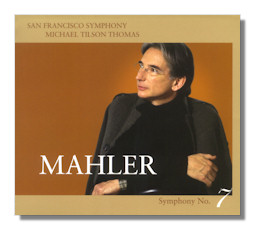
The Internet's Premier Classical Music Source
Related Links
- Mahler Reviews
- Latest Reviews
- More Reviews
-
By Composer
-
Collections
DVD & Blu-ray
Books
Concert Reviews
Articles/Interviews
Software
Audio
Search Amazon
Recommended Links
Site News
 SACD Review
SACD Review
Gustav Mahler

Symphony #7 in E minor
San Francisco Symphony Orchestra/Michael Tilson Thomas
San Francisco Symphony SACD 821936-0009-2 Hybrid Multichannel
"Even though the music of Gustav Mahler has not been central to Michael Tilson Thomas's discography, the elusive Seventh Symphony has taken him to a new peak in what is already a distinguished career." So wrote Raymond Tuttle in 1999, and so it was. In the decade that followed, the conductor would embark on a complete cycle with his San Francisco forces. None of us had any idea – least of all myself, since I was 12 – that when Tilson Thomas released RCA Victor Red Seal 09026-63510-2 with the London Symphony Orchestra, it would be the beginning of his extensive journey with the composer.
This newer 7th has many things to offer, not least the tremendously confident playing of the San Francisco Symphony. The strings and brass are uniformly stunning, aided by quality sound production from the orchestra's house label. If anything, it's too pretty. The conductor's previous effort in London may have lacked the last ounce of polish, but was a touch more interesting in the opening two movements. It was more expansive, too; this latter recording needs only one disc. Still, you have to admire the good here, the whole affair sounds very beautiful, and flows very well.
The Symphony gathers steam as it proceeds. The weird sounds of the Scherzo are appropriately strange, and there is genuine tension for the first time. The sections of the orchestra not only sound a little fuller, they are also far more willing to respond to the spooky atmosphere that the piece demands. Tilson Thomas also seems more involved, and pushes his ensemble more as the work progresses. The Nachtmusik II brings out all the unusual instruments – mandolin and guitar among them – that are introduced here. There is some very special playing here, and it's nice to be able to hear each of the instrumental voices so clearly.
The Finale is superb. The brass playing is nothing short of electric, with the entire section simply going nuts throughout. Tilson Thomas brought this work to Michigan in November 2014, and my musical friends and colleagues simply raved. Now I finally understand why. The conductor and orchestra create such a powerful and convincing Finale that it feels not like 18 minutes, but only a few. How many moments in Mahler do you really want to stop and play it all again? There are not many, and this is from someone who has sung Mahler, studied and written on Mahler…no, these are the magical moments that you hope happen on disc, but so seldom do. Although the conductor's previous RCA effort is still an important entry in his discography, the last three movements or so make this required listening for the conductor's many admirers.
Copyright © 2014, Brian Wigman




















